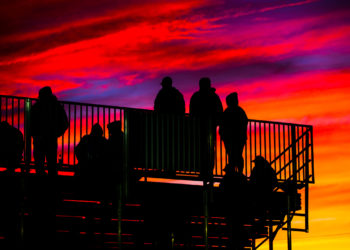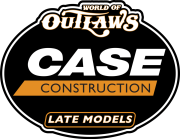Florida is a unique peninsula to motorsports. More international racers have used it as a winter escape than a base of operations, Bill France and Smokey Yunick excluded. France famously suffered car trouble in Daytona Beach and decided it was as good a place as any to launch NASCAR America. Smokey flew an airplane above the same Atlantic Ocean resort and built “The Best Damn Garage in Town” along its Halifax inlet.
Daytona had the most diabolical oval: two miles south on A-1-A asphalt then left into the sand and north another two miles into a high banked hairpin strewn with wreckage. Upwards of 80 stock cars raced ‘til the tide crept in. Hooker Hood and Gus Linder ran the beach on their way to the National Sprint Car Hall of Fame. The best damn Pontiac won the final race for Yunick and motorcycle legend Paul Goldsmith. It was time to leave the sand. Bill France had seen the Indianapolis 500, seen Darlington rise and flourish. So, Big Bill put the speed in speedway.

Six decades later, it is still impossible to imagine Florida Speedweeks without the Daytona 500 as its focal point. For proof, just try to find Wednesday Sprint Cars after “The Great American Race” has reached its smashing conclusion.
Sprint Cars were spraying seashells on the Gulf Coast during the same days when stock cars kicked sand in the ocean. Those races happened at the first of Tampa’s two Florida State Fairground half-miles commonly called Plant Field. IMCA Winter Nationals occupied the main stage on five afternoons annually though not consecutively. Lee Osborne and Will Cagle competed at Daytona and Tampa on the same day. Johnny Rutherford traced a richer path. The Texan made his Florida debut with IMCA before Yunick hired Rutherford for the 1963 Daytona 500. Smokey had seen “Lone Star J.R” last 100 laps on Salem’s high banks aboard a cageless USAC Sprint Car and figured Daytona would be a breeze.
Plant Field fell in 1976 when it was replaced by East Bay Raceway as home to Sprint Cars of the Tampa Bay Auto Racing Association. East Bay opened Ted Johnson’s first true championship trail of the World of Outlaws on four February nights in 1979. Two years later, Johnson scheduled Outlaws on three nights without wings then returned a week later for three shows with them. Ted’s plan in 1981 was to visit Volusia County Speedway in a winged Monday precursor to East Bay’s second week. But wet weather delayed the wingless conclusion until after Volusia, where the Outlaws did not return for 24 winters.
Johnson’s third Florida venue in Jacksonville was a curious case. Just across the Georgia line, Jax Raceway was unfinished pavement: hard-packed sand coated with waste oil. Environmental whistles would sound today. Not so in 1983. Jax had a sweeping fast D-shape. Cars that sailed off fenceless turn three were kept clear of pecan trees by hundreds of used street tires. Each driver’s meeting began with a warning to stay in the seat to await safety personnel in tall boots because snakes liked those tires too. Armed with antivenom, Outlaws started 1983 at Jax on a Saturday afternoon with the next day’s A-main slated for NBC television tape. Then it rained. The Outlaws never returned. According to official records, they never raced there at all. It took 34 years and a new regime to bestow full credit on preliminaries such as Jax.
Johnson grew sour about his citrus league. It just rained too much. His last Winter Nationals at East Bay was delayed by three days. All Stars opposed him on the other end of I-4. Johnson lived in Texas. Why not start in Dallas and leave East Bay, Volusia and Jax to Bert Emick? Four years passed without an Outlaw race in Florida. It took Big Money to bring them back. The new Florida State Fairgrounds opened the 1988 World of Outlaws trail with four nights culminating in a (18k) check larger than any except Kings Royal or Knoxville Nationals, all $95,000 of which went to Steve Kinser in 1988.
Another three years passed until Ted Johnson returned to Florida to put his stamp on the first Sprint Car race ever under a roof. The venue in St. Petersburg was the Suncoast Dome rebranded as Tropicana Field upon finally luring Major League baseball. The dome was two years old and desperate for tenants in 1992 when Tampa’s Paul Morgan leased it as a weekend dirt track. Johnson knew Morgan as car owner to Rick Ferkel and Bobby Davis Jr. He knew indoor racing could broaden his base. America had seen Mickey Thompson fill stadiums for bikes and trucks. Why not Sprint Cars? As an artistic endeavor, racing in St. Pete was passable and fumes bearable. But the promoter welched on the purse so the whole episode elicited a bad smell that still lingers. Ask anyone in 2021 about the dome in 1992 and they will immediately answer with the precise amount of money that Paul Morgan still owes them.
Outlaws really questioned their leader when Ted’s first three stops of 1992 were indoors, asphalt and Mexico. The second event at Charlotte County was historic because it marked the first point race on pavement and the first All Star Circuit of Champions co-sanction. Two months later in Kansas City “The Greatest Show on Dirt” became 100 percent dirt. Florida tempted Ted with a new dirt track in St. Augustine where Outlaws opened three seasons before asphalt was spread across its half-mile saucer.

Volusia Speedway Park has kicked off 21 straight seasons by the World of Outlaws. No facility ever evolved in quite the same fashion. Volusia began as oiled dirt in 1968, found better dirt, tarred and feathered its nest for eight years then returned to earth. To appease fans of each surface, the property sprouted a smaller dirt track that was paved in 1998 and dead by 2001. During five Florida Speedweeks, one Volusia ticket allowed fans to float between dirt and asphalt racing all night long.
If that does not sound crazier than a landlocked alligator, you must be in a Sunshine State of mind.
This year, Volusia Speedway Park will host the 50th DIRTcar Nationals, Feb. 2-13. The first week featuring the World of Outlaws NOS Energy Drink Sprint Cars. All Star Circuit of Champions and the DIRTcar UMP Modifieds and the second will see the continuation on UMP Modified action, DIRTcar Late Models, the World of Outlaws Morton Buildings Late Models and the Super DIRTcar Series.
For tickets, click HERE.
If you can’t make it to the track, you can watch all the action live on DIRTVision with the annual Platinum FAST PASS subscription for $299/year or the monthly FAST PASS subscription for $39/month.














